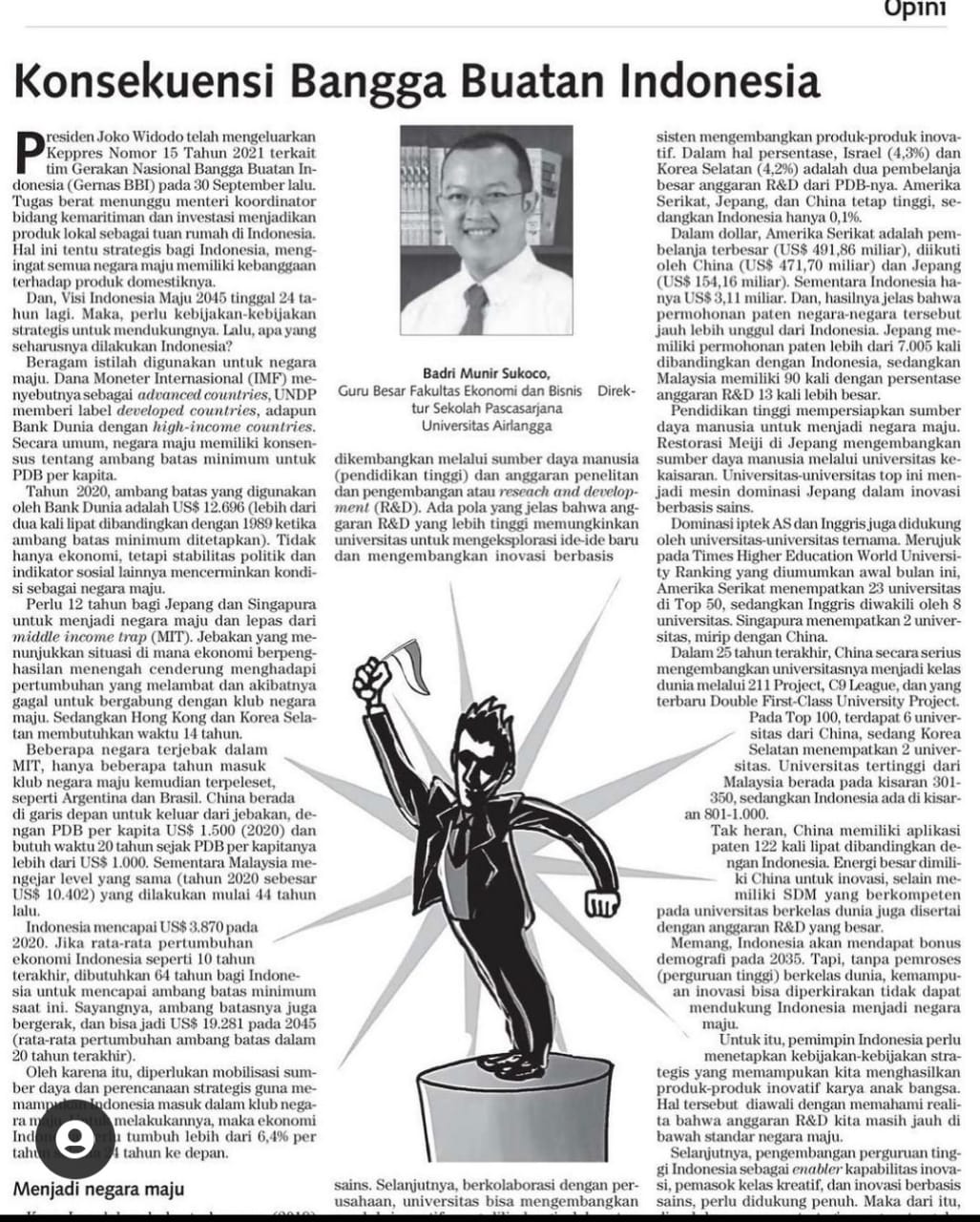????????????????????????????????????????????? ???????????????????????? ???????????????????????? ????????????????????????????????????
Badri Munir Sukoco
Professor, Faculty of Economics and Business,
Director of Postgraduate School,
Universitas Airlangga
https://insight.kontan.co.id/news/konbisnis-bangga-buatan-indonesia
President Joko Widodo has issued Presidential Decree number 15 of 2021 regarding the Proudly Made in Indonesia National Movement (Gernas BBI) team last September 30.
A tough task awaits the Coordinating Minister for Maritime Affairs and Investment to host local products in Indonesia. This is certainly strategic for Indonesia, considering that all developed countries have pride in their domestic products. And Advanced Indonesia 2045 is only 24 years away, and strategic policies are needed to support it. What should Indonesia do?
???????????????????????? ????????????????
Various terms are used for developed countries. The IMF calls it ????????????????????????????????? ????????????????????????????????????, UNDP calls it ??????????? ??????????????????????????? ????????????????????????????????????, as for ???????????? ???????? ?????????????????? with ℎ?????????ℎ-???????????????????????? ????????????????????????????????????. In general, developed countries have a consensus on the minimum threshold for GDP per capita. In 2020, the threshold used by the World Bank was US$12,696 (more than double compared to 1989 when the minimum threshold was set). Not only economic, but political stability and other social indicators reflect conditions as a developed country.
It took 12 years for Japan and Singapore to become developed countries and escape from ???????????????????????? ???????????????????????? ?????????????????? (MIT). A trap that represents a situation where middle-income economies tend to face slowing growth and consequently fail to join the club of developed countries. Meanwhile, Hong Kong and South Korea took 14 years.
Several countries were trapped in MIT, only entered the club of developed countries for a few years and then slipped, such as Argentina and Brazil. China is at the forefront of breaking out of the trap, with a GDP per capita of US$1,500 (2020) and it has taken 20 years since it was over US$1,000. Meanwhile, Malaysia is pursuing the same level (2020 – US$10,402) starting 44 years ago.
Indonesia reached US$3,870 in 2020. If Indonesia's average economic growth is like the last 10 years, it will take 64 years for Indonesia to reach the current minimum threshold. Unfortunately, the threshold is also moving, and could be US$19,281 in 2045 (the average threshold growth in the last 20 years). Therefore, resource mobilization and strategic planning are needed to enable Indonesia to enter the club of developed countries. To do this, Indonesia's economy needs to grow at more than 6.4% per year over the next 24 years.
???????????????????????????? ???????????????????????? ????????????????
Keun Lee in his latest book (2019) argues that the economic growth of developed countries is correlated with higher education and innovation capabilities. Innovation capabilities are developed through human resources (higher education) and R&D budgets. There is a clear pattern that higher R&D budgets enable universities to explore new ideas and develop science-based innovations. Furthermore, collaborating with companies can develop innovative products protected by patents with higher added value.
Clearly, developed countries have large enough R&D budgets to consistently develop innovative products. In terms of percentages, Israel (4.30%) and South Korea (4.20%) are the two big spenders of its GDP R&D budget. The United States, Japan and China remain high, while Indonesia is only 0.10%. In dollar terms, the United States was the biggest spender (US$491.86 billion), followed by China (US$471.70 billion) and Japan (US$154.16 billion). Meanwhile, Indonesia is only US$3.11 billion, and the results are clear that the patent applications of these countries are far superior to Indonesia's. Japan has more than 7,005 patent applications compared to Indonesia, while Malaysia has 90 times with a percentage of R&D budget 13 times larger.
Higher education prepares human resources to become a developed country. The Meiji Restoration in Japan developed human resources through imperial universities. These top universities are the engines of Japan's dominance in science-based innovation. The dominance of US and UK science and technology is also supported by well-known universities. Refer to ???????????????????? ????????????ℎ???????? ???????????????????????????????????? ????????????????????? ?????????????????????????????????????????? ?????????????????????????????? announced earlier this month, the United States placed 23 universities in the Top 50, while the UK was represented by 8 universities. Singapore hosts 2 universities, similar to China.
In the last 25 years, China has seriously developed its universities to become world class through 211 ????????????????????????????, ????9 ? ????????????????????????, and the latest ??????????????????????? ? ?????????????????????-????????????????????? ?????????????????????????????????????????? ??????????????????????????????. In the Top 100, there are 6 universities from China, while South Korea has 2 universities. The highest universities in Malaysia are in the range 301-350, while Indonesia is in the range 801-1000. It is not surprising that China has 122 times as many patent applications as Indonesia. China has great energy for innovation, apart from having competent human resources at world-class PT, it is also accompanied by China's large R&D budget.
It is true that Indonesia will get a demographic bonus in 2035. However, without world-class processors (universities), it is predicted that innovation capabilities will not be able to support Indonesia to become a developed country.
????????????????????????????????????????????
Indonesian leaders need to establish strategic policies that enable us to produce innovative products created by the nation's children. This begins with understanding the reality that our R&D budget is far below the standards of developed countries. Furthermore, Indonesian universities as ???????????????????????????? innovation capabilities, creative class suppliers, and science-based innovation, need to be fully supported. A mature strategic plan with a special budget is needed to realize Indonesia as a developed country by 2045.
























